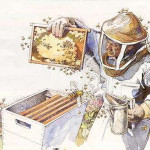Created by: absit.nomen
Number of Blossarys: 5
The term brood is used to refer to the embryo or egg, the larva and the pupa stages in the life of holometabolous insects. The brood of honey bees develops within a bee hive. In man-made, removable ...
A bee sting is strictly a sting from a bee (honey bee, bumblebee, sweat bee, etc.). In the vernacular it can mean a sting of a bee, wasp, hornet, or yellow jacket. Some people may even call the bite ...
Foraging is searching for and exploiting food resources. It affects an animal's fitness because it plays an important role in an animal's ability to survive and reproduce. Foraging theory is a branch ...
Colony collapse disorder (CCD) is a phenomenon in which worker bees from a beehive or European honey bee colony abruptly disappear. While such disappearances have occurred throughout the history of ...
A new honey bee colony is formed when the queen bee leaves the colony with a large group of worker bees, a process called swarming. In the prime swarm, about 60% of the worker bees leave the original ...
Honey extraction is the central process in beekeeping of removing honey from honeycomb so that it is isolated in a pure liquid form.
Pollination is the process by which pollen is transferred in the reproduction of plants, thereby enabling fertilization and sexual reproduction. Bees pollinate 80% of agricultural crops.


 English (EN)
English (EN) 
